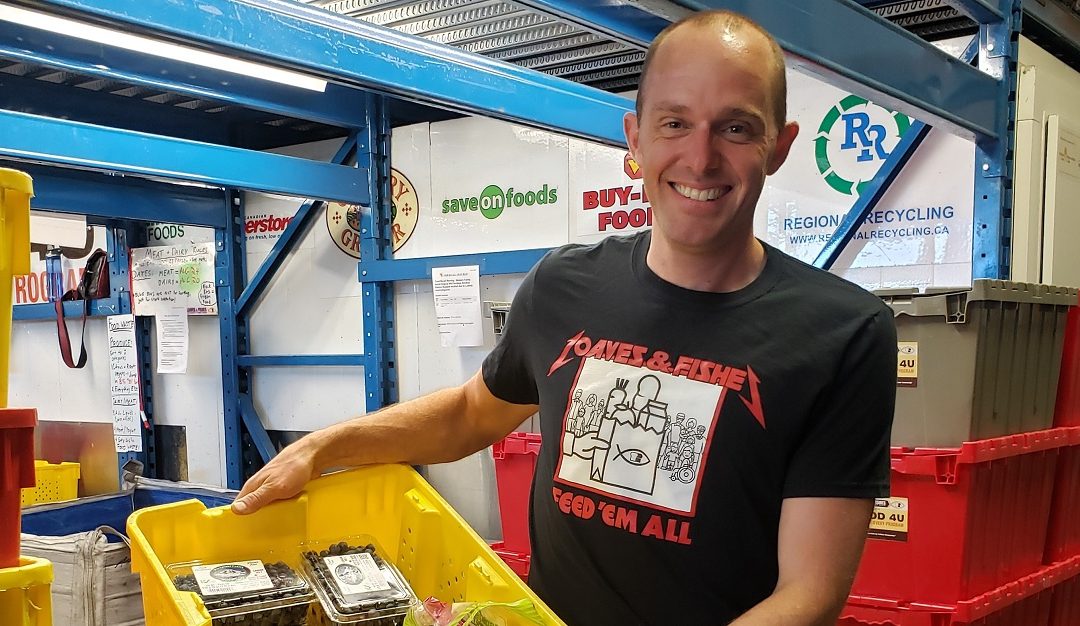By Stacey McLachlan. Originally published in the fall 2019 issue of Business Class magazine.
Overstocked meat. Misshapen apples. Unsold hummus. Damaged boxes of pasta. To some people, it may look like the item that gets put back on the shelf, but to Peter Sinclair, BCom ’99 and executive director of Nanaimo’s Loaves and Fishes food bank, it’s treasure waiting for a home.
Though Sinclair works in the non-profit sector, his business school training helped him bring a unique entrepreneurial perspective to the job—one that guided him to launch an innovative food recovery program that diverts potential food waste to people in need. Items that grocery stores or delivery companies can’t sell (perishable products, damaged goods, inventory overstock), can now be quickly and easily donated to Loaves and Fishes, and the impact has been staggering. In 2012, Sinclair’s organization put $800,000 worth of food back into the community. In 2019, with the recovery program in full swing, the amount rose to $4.6 million, and this year, Sinclair’s team is forecasting close to $5 million.
“When you can talk about putting millions of dollars’ worth of food into the hands of the most vulnerable people in our community, that’s an awesome profit,” he says.
One might not assume a business degree would translate to food bank work, but to Sinclair, it feels like a natural fit. “When I was at UVic, they were trying to teach a mindset that could be applied to whatever type of work and life you pursue—not just business, but government and non-profits—so students can achieve everything they can be,” he recalls.
Inspired by a tour of a Kamloops food bank with a food recovery program, Sinclair saw an opportunity in diverting food waste when he started as the executive director at Loaves and Fishes in 2011. He worked with the Kamloops team to get materials and information about how to approach grocery partners, and ran with it from there. Loaves and Fishes now teams up with local groceries, wholesalers and trucking companies with one basic rule: If it’s food, regardless of condition, they’ll take it.
“When we’re approaching stores and wholesalers, we’re approaching them as business partners with a proposition to help them make more money,” explains Sinclair. “We recognize these groceries are paying a huge amount of money to dispose of food that’s damaged, overstocked, or outdated, and we come to them with a solution.” Loaves and Fishes supplies donation bins, and will collect them up to seven days a week. A team of volunteers sorts food at the warehouse: anything that’s inedible goes to local farmers for animal feed or compost.
Instead of going to the landfill, food recovered by Loaves and Fishes now feeds more than 7,000 people a year. One recent win? Seven palettes of prime rib from a local grocery store.
“They called us to say they had $20,000 of prime rib that they could not sell, and needed it gone, so we jumped in the truck and made the pickup,” says Sinclair. “You have to have the truck and the people available to solve the problems for these grocery stores. If you can be ready, you can capitalize on some great opportunities.”
Of course, it wasn’t easy to get to this place, and it didn’t happen overnight. “We started with $3,000 and bought some bins for a grocery store three blocks away, and we’ve grown from there,” says Sinclair. Strategic decisions—not always easy decisions—were made with long-term gains in mind. That meant scaling back on retail food purchases to reallocate resources to food collection. Sinclair argues that grocery store margins are so slim, that even with high-volume purchases, the food bank’s dollar isn’t going to go much farther than an average consumer’s.
“Maybe you’ll save 15 cents if you buy 10 palettes,” says Sinclair. “There’s a better way of doing it. Instead of buying that food, take that money and deploy it to get the food that’s already out there and going to waste.”
Prior to the launch of the program, Loaves and Fishes was spending $10,000 a month on purchasing milk. Sinclair and the team made the decision to take that money and put it into food recovery, paying the wages and overhead to make that happen. A total fleet of six vehicles was expensive to purchase, and remains expensive to maintain. But while controversial at the time, these investments have paid off immeasurably for the community in the long run.
Sinclair’s unique approach has all the hallmarks of entrepreneurs—the calculated risks, the unconventional approaches—and it’s paying off with its own form of dividends: more food for more people, and less food in the trash.
“These are things non-profits are not supposed to do,” says Sinclair. “The safest thing you can do as a food bank is buy food. No one will criticize you—except me—but you miss out on the potential opportunity to have a much greater impact.”
Photo: Abby Sauchuk


